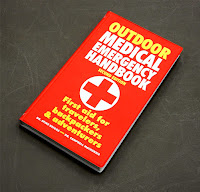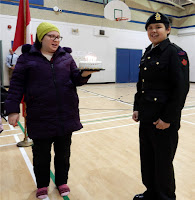The course kicked into
high gear on the second day.
We started the second day with a
quick review of what we reviewed on the first day. Then we moved on to our first scenario:
safely removing an injured person from a vehicle. We used one of the teacher’s vehicle in the
parking lot for practice. The scenario
was kept simple; the car was not overturned.
There are too many possibilities & positions of how an occupant
inside a vehicle may end up after an accident.
As long as the basics are practiced & mastered, then everything
should be okay. The main things we
learned were: don’t break the neck, don’t puncture the heart, and don’t cause
excessive bleeding.
 |
| Dragonfly stove. |
We moved to the back of the building
where Arctic Response stores all of its training equipment. There we learned how light & operate
dragonfly stoves. They’re like Coleman
stoves but much smaller and more compact.
These stoves are also used during field training exercises in the
Canadian cadet program. Everyone got the
chance to light & turn off a dragonfly stove.
The next lesson was how to wrap and
keep an injured person warm while waiting and or transporting them to
safety. This involved a tarp, sleeping
bag, and lots of rope. Basically, the
tarp is laid down on the ground, followed by the sleeping bag. The injured person is carefully placed inside
and then wrapped in a cocoon of warmth.
The ropes are tied across to keep everything together. Additional ropes can be added for pulling.
We moved outside to practice. I was glad I brought my heavy winter
clothing. We were split into groups of
three: one would act as the injured person while the other two would be the
rescuers. The exercise was a “wrap &
drag.” The two rescuers had to pull the
injured person for a determined length after wrapping them. Unfortunately, I was a rescuer. The total distance was about 200 metres. Pulling a wrapped person is no easy task,
even with two people. And if your out on
the arctic ice with no working skidoo, it’s the only way to close the distance
between you & help. I learned that
there will be a lot of stopping-to-catch-your-breath moments but there’s no
avoiding that. Everyone was tired at the
end.
After lunch, we learned how to
administer oxygen from an oxygen tank.
To make a long story short, we just have to remember to watch where
we’re pointing the oxygen tank, and to be careful when working the metal
regulator. If you’re not careful, the
tank may turn into a rocket, fly away, and injure someone.
The last lesson of the day was
learning to use disposable resuscitators and oral airway tubes. These would most likely be included in
emergency kits out on the land because they’re easier to use than oxygen
tanks. They’re made out of plastic and
are designed to keep a person alive and breathing. The oral tubes are designed to create a
breathing path in the mouth. We
practiced on dummies.
I felt like a first-time student by
the end of the second day. The
instructor informed us that the field of emergency response continual evolves
and changes with every passing year.
 |
| Me practicing administering oxygen. |
On the third day of the course we
were introduced to the first aid and medical supply company Sands Canada. The instructor showed us their website and
what we could purchase from them. In
short, everything & anything. I
wrote the website down for safe keeping.
We practiced administering oxygen
again. I had someone take a picture of
me practicing on a dummy. I needed proof
that I was learning and doing things correctly.
 |
| Stethoscope |
 |
| Measuring blood pressure. |
We moved on to finding &
checking pulses, how to use a stethoscope, and manually check blood pressure. I’ve always had difficulty finding a pulse on
someone. Not sure why? Practice makes perfect, I guess. Using the stethoscope, blood pressure cuff,
and sphygmomanometer were much easier.
Now I just have to work on my pronunciation of the word
sphygmomanometer. It’s quite a tongue
twister.
The 4th & 5th
days of the course were all about: wrapping exposed wounds, making splints,
using stretchers with head blocks, safely removing objects, and administering
liquids. The instructors showed us the
proper procedures and then we practiced in pairs.
 |
| The instructors showing us how to wrap an exposed wound. |
 |
| Orange splint. |
I
was amazed by how much gauze was needed to secure & wrap an exposed wound
and tie a splint around a leg. They’re
easy to use but easy to waste. Pack a
lot of spare rolls when travelling in groups.
The “high-tech” stretcher with the spider straps and head blocks was really
impressive. The cadet corps in Arctic
Bay only has the basic military stretchers and I’m not sure about Inuujaq
School. The spider straps securely
attach the body to the stretcher and the head blocks immobilize the head to
prevent further injury.
 |
| Stretcher with spider straps & head blocks. |
People
who take first aid classes are usually taught to never remove a protruding
foreign object from an injured person because it may lead to further
problems. In this course, we were told
that that way of thinking can actually be bad for the person in distress because
help is many hours and possibly days away.
To increase chances of survival, we need to carefully & properly
remove such foreign objects from the body and then wrap the exposed wound. The instructors showed us how to remove some
common objects, such as, fish hooks, small knives, and harpoon heads.
 |
| Me practicing administering liquids. |
If an injured person is unable to swallow
and/or the stomach can’t handle foods & liquids, then the only way to
administer liquids is to go through the back.
When I say “the back”, I mean a certain place where the “sun doesn’t
shine”. The process involves using a
tube, and a large plastic syringe full of water. We practiced using cups of water and wore latex
gloves. Graphic? Yes.
Uncomfortable? Definitely. But it’s a last resort procedure to keep a
patient alive. If I ever have to do this
in real life, I hope I don’t pass out.
I should point out that the instructor showed
us photographs of various types of injuries that we may encounter when out in
the wilderness. The photographs were not
pretty to look at. We saw cuts, bruises,
burns, broken limbs, blood, death by carbon monoxide poisoning, and scalped
heads from bear attacks. The images
briefly made me question why I was taking the course. Emergency response is never pretty; you have
to be prepared to see & deal with some serious situations. I commend everyone in the medical fields for
doing what they do.
 |
| All the stuff we used during the course. |
We had a final practical
test & written test on the fifth and final day of the course. The practical test occurred outside and was a
simulated accident. We had to triage and
use everything we had learned over the course of the week. The written test was multiple choice and we
needed to score at least 75% to pass. I
breathed a sigh of relief when I found out I had passed both tests. Our results would be recorded and we would
receive our cards in the mail in about a month.
Our certifications would be valid for 3 years.
We thanked the
lead instructor for being our instructor.
We were free to go after completing the feedback form. We were also allowed to keep the red textbook.
To
Be Continued . . .

















































